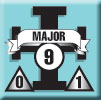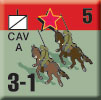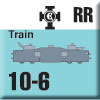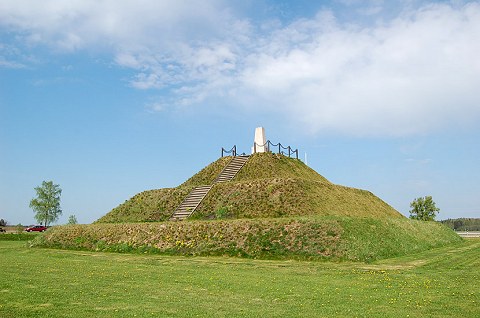The Mouse That Roared:
A Preview (Part One)
By Mike Bennighof, Ph.D.
April 2015
For the past decade, the Baltic Defence College in Tartu, Estonia has instructed officers from Estonia, Latvia and Lithuania in a variety of staff courses. Teaching materials include Infantry Attacks: The Mouse That Roared.
We’ve had a few of our games make an appearance on the syllabus in both military and civilian universities – including at least one university that used Survival of the Witless to prepare graduate students for the hell of the real-life tenure game. It’s even more gratifying to get the nod for a historical product, since we strive for high standards of historical accuracy and play value. Here’s a look at the scenarios found in The Mouse That Roared:

Scenario One
Opening Volleys
18 November 1918
On March 3, 1918, the Treaty of Brest-Litovsk, between the new Russian Soviet Federated Socialist Republic and the Central Powers, marked Russia's exit from World War I and her cession of territorial rights to Estonia, Livonia (Latvia), and the Ukraine. The Germans landed on the mainland of Estonia in mid-February prior to the treaty being signed, and completed their occupation of all territories by February 24th. This occupation was not bloodless as the Germans suffered 368 dead and about 1400 wounded fighting various Russian, Red Estonian, and nationalist Estonian forces.
The German occupation of Estonia lasted just nine months until the German Revolution in November 1918 and the subsequent Armistice that ended her war with the Allies. On 14 November, representatives of Germany formally handed over political power in Estonia to the newly formed national government. Only 14 days later the Bolshevik Russians launched their Soviet Westward Offensive aimed at seizing all the Baltic and Ukrainian territory lost to Imperial Germany, thus initiating the fifteen-month Estonian War of Independence.
The northern wing of the Red offensive struck the border city of Narva on 28 November 1918, as the 6th Red Rifle Division attacked units of the hastily-assembled paramilitary Estonian Defense League and German Infantry Regiment 405 defending the city. (The Treaty of Versailles had required Germany to maintain border guard units on the eastern front to guard against the Bolshevik threat.) The 6th Red Rifle Division consisted of 2,800 infantry, 6 field guns, an armored train, 2 armored cars, a naval landing party of 700 men, and the Bogatyr-class cruiser Oleg and two destroyers. Facing them were roughly 750 dispirited Germans, a couple dozen machine guns and artillery pieces, along with an equal portion of the Estonian military forces, which at the time totaled only 2000 men with light weapons and about 14,500 poorly armed Home Guard spread across three fronts (north, southeast, and south). The Soviet goal was to quickly crush this rebellion, reestablish control over the region, and work on consolidating their power base against the White Forces arrayed against them. Estonia wanted independence.
Conclusion
The Germans and Estonian militia repulsed the first attempted crossing of the Narva River, but a large naval landing flanked their position on the second attempt. The 6th Red Rifle Division captured an abandoned Narva on 29 November. The Soviets kept up the pressure immediately pushing further west toward the critical Tapa railway junction that they seized on 24 December, having marched and fought across 120km in less than a month. But their eye was on the final prize, Tallinn. Estonian Bolsheviks declared the Estonian Workers' Commune in captured Narva. As the Reds won successes everywhere the future of Estonian independence began to fade.
Notes
This is a relatively small scenario, with the Reds pressing to take the town from the combined German-Estonian defenders. The Reds have an armored train, a potent weapon in 1918 with the Estonians possessing little that can harm it, a small edge in numbers, and a decided advantage in morale.

Scenario Two
Almost, But Not Quite
4 January 1919
The 7th Red Army led by the 6th Red Rifle Division was beating the hodgepodge of German and Estonian forces thrown in their path as they advanced westward toward Tallinn, but their supply line was getting longer. In addition, the delays were buying time for Commander-in Chief Johan Laidoner to field, equip, and train more troops. Foreign assistance also poured in, as Finland delivered 5000 rifles and 20 field guns together with ammunition, and a British Royal Navy squadron commanded by Rear Admiral Sir Edwyn Alexander-Sinclair arrived off Tallinn on 31 December, delivering 6500 rifles, 200 machine guns and 2 field guns. On January 2, 2,000 Finnish volunteers arrived in Estonia as well. And hardworking rail workers and military armorers put the finishing touches on three armored trains in Tallinn under the command of Captain Anton Irv. Approximately 40 kilometers from Tallinn, the Estonian 1st Division deployed 5,700 men to meet the onrushing 8,000 Soviets. It was make or break time.
Conclusion
The armored trains supporting the Estonians surprised the Russians. Combining that with accumulated fatigue, low supplies due to their rapid advance and the tenuous logistic system supporting them, as well as the frigid conditions, it was all too much for the Russians. After several attempts to punch through or flank the Estonians failed, the Reds fell back and dug in, awaiting reinforcements and new orders.
Notes
The Estonians have gotten much tougher in the six weeks since the first scenario: their morale is slightly better than that of the Reds, and they have artillery of their own now plus two armored trains. They’re going to need all of that in this mid-sized scenario, as the Reds have numbers but a daunting task.

Scenario Three
Liberating the Center
14 January 1919
Tartu, located in the center of the country, is the second largest city of Estonia and often considered the intellectual and cultural hub since it is home to Estonia's oldest and most renowned university. As part of the Soviet invasion, the 49th Red Latvian Rifle Regiment of the 2nd Novgorod Division captured the town of Tartu on Christmas Eve 1918. Their plan was to continue pushing north toward Tallinn while other Russian forces drove west toward the same objective. The Estonians were not idle, but instead were frantically building up their military with aid from sympathetic western countries and mass volunteerism. On 7 January 1919, Estonian Commander-in-Chief Johan Laidoner counterattacked the Russians across the width of the country. He tasked the 2nd Division under Colonel Viktor Puskarin and his subordinate commando units to liberate Tartu. On the 14th they were in position to try.
Conclusion
The Red Latvians were caught by surprise by the Tartumaa Partisans who knew the area intimately. The addition of the trains’ firepower helped unnerve the Latvians who, though resisting in scattered groups, eventually fled south to reestablish their line and get reinforcements. Meanwhile the Estonians would use the rail line to bring in more regular units to keep the Latvians and Russian on the run.
Notes
The Estonian Partisans are elite light infantry, making a lightning raid on the Reds helped by two trains and a little cavalry. Infantry Attacks actually models mobile actions like this one quite well. The Estonians are outnumbered but have all the cool units on their side.

Scenario Four
Cut Off!
17 January 1919
After two days of mopping up and preparations, the Estonians launched their own counteroffensive on 7 January 1919. The Soviet forces began to retreat faster than they had advanced. With the support of armored trains, the 1st Estonian Division liberated Tapa railway station on 9 January, followed by Rakvere on 12 January. As they approached Narva the Estonians devised a plan to eliminate the 6th Red Rifle Division rather than just keep driving them back. With the help of the British Royal Navy, a thousand-man Finnish-Estonian force landed at Utria on 17 January, to the east of the 6th Red Rifle Division, thus cutting off their retreat. It was hammer and anvil time.
Conclusion
The trap was partially effective, dispersing the Soviets but not entirely destroying them. With the Soviet units opposing them scattered and disheartened, the Estonians liberated Narva on 18 January. Subsequently, the northeastern front stabilized along the Narva River. In just 11 days, the 1st Division had advanced 200 kilometers. Of course, this was a bad time for the Soviets who were losing ground on all fronts. Although the Bolshevik government firmly controlled the core of Russia from Petrograd through Moscow and south to Tsaritsyn, it was ringed with enemy armies. Admiral Aleksandr Kolchak and his small White army in the Perm area controlled a portion of the Trans-Siberian Railroad. In the south the White Armies occupied much of the Don and Ukraine. In the Caucasus near Kazan, General Anton Denikin had established a new White army. The British occupied Murmansk and most of the Black Sea shore, while they and their US allies occupied Arkhangelsk, and the Japanese occupied Vladivostok. This gave great hope to the Estonians.
Notes
There’s only been one of these in Panzer Grenadier: a scenario with armored trains on both sides. The Reds are fleeing along a long corridor, with the Estonians in hot pursuit with trains, cavalry and the “Sons of the North Finnish Volunteer Regiment.”

Scenario Five
Sacrifice at Paju
31 January 1919
Paju Estate sprawls across a bucolic farmland with scattered woods northeast of Valga along the Latvian frontier. Having driven the Red Latvians back for nearly 60 kilometers since the recapture of Tartu two weeks earlier, the Tartumaa Partisan Battalion and their Finnish volunteer allies would strike them again here, where the Red invaders had made their headquarters. For their part, the Reds were trying to stiffen their force which had crumbled under the incessant attacks of the Estonians, losing quite a bit of equipment in the process. They needed to stop the Estonian advance to Valga which would cut the only rail line from Russia to Riga and imperil their whole operation in the west.
Conclusion
During the initial assault on the 31st the charismatic commander of the Tartumaa Partisan battalion, Julius Kuperjanov, was fatally shot. His deputy Lt Johannes Soodla continued the attack accompanied by Col Hans Kalm and his Finnish Volunteers and eventually swept the Latvians from their positions after nightfall in brutal hand-to-hand fighting. The bloody Estonian victory resulted in the bloodless liberation of Valga the following day. The victory cut the Soviets’ railway supply line and denied them the use of their armored trains in the west. Quickly the rest of southern Estonia was liberated and Estonian troops advanced into northern Latvia.

To honor Julius Kuperjanov, who died of wounds on 2 February, the Tartumaa Partisan Battalion was renamed Kuperjanov's Partisan Battalion. The Estonian Defense Force today still includes the Kuperjanov Battalion. The battle is commemorated on the estate grounds by a granite monument on a three-step pyramid of earth.
Notes
This one’s a relatively small scenario, with mobile Estonian/Finnish light infantry trying to grab the town from the lower-morale Reds as quickly as possible. The Reds have a slight numerical advantage, and a lot of machine guns. The Estonians have their julgust and some imported sisu.
Mike Bennighof is president of Avalanche Press and holds a doctorate in history from Emory University. A Fulbright Scholar and award-winning journalist, he has published over 100 books, games and articles on historical subjects.
He lives in Birmingham, Alabama with his wife, three children and his dog, Leopold. |
